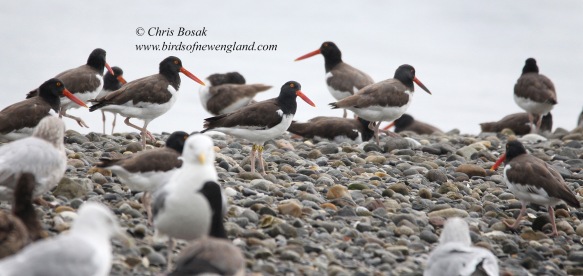
Ask me what my favorite bird is and I’ll likely give you a different answer every time. Truth is, I have lots of favorite birds. Now I just say “that’s one of my favorite birds” when I see one of the dozen or so species that fit the category.
The American oystercatcher is one species that has long fit into that category – probably from the first time I saw one. While many shorebirds blend in with the sand or rocky habitat and look nearly identical to each other, the American oystercatcher stands out with its larger size, contrasting plumage and, of course, its large orange-red bill.
Aside from its cool appearance, oystercatchers have a high-pitched call that may be heard from a great distance. I have often visited the shore and thought I struck out in my quest to find an oystercatcher only to hear that call on a nearby sandbar. The call is often made in flight so it’s easy to find them and track them to their landing spot.
Obviously, if it is one of my favorite birds, it is exciting when I visit the coast and see one, or a pair, or a small family group of three or four. The other day, however, was an oystercatcher bonanza as there were dozens of them gathered on a sand spit jutting into Long Island Sound in southern Connecticut.
It was a reminder of why it is so important to get out there to look for birds during migration periods, be it spring or fall migration. I had been to this sanctuary many times before and have seen oystercatcher pairs and small family groups on many occasions. This was the first time, however, that I had seen so many of the fantastic birds.
Unfortunately, my time was short. A storm was rolling in as I walked along the sand. The sky above me and to the east was blue with puffy clouds. The sky to the west was midnight blue to black and looking as ominous as you could imagine. I hadn’t even noticed the darkness when I started my walk. The walk from the parking lot to the beach at the sanctuary is relatively short, only about five minutes, but the storm was moving slowly, but steadily in my direction.
I kept an eye on the darkness to the west as I continued along the rocky beach. The water’s edge was filled with shorebirds such as dunlin, sanderlings, semi-palmated plovers and a few varieties of sandpipers. It is true that the shorebird migration starts in the middle of summer, but it was in full swing on this mid-September afternoon.
I hadn’t noticed the oystercatchers at first, but when I trained my binoculars on the sand spit, I noticed one, then two, then ultimately dozens of them out there. At rough count, I’d say there were 30 to 40 of them. A few ring-billed and herring gulls and several brant joined the oystercatchers on the small piece of sandy land.
I approached close enough to get a few shots with my telephoto lens extended out to its maximum. With the storm clouds now overhead and the birds already feeling the many stresses of migration, I did not approach too closely and risk flushing the birds. They need all the energy they can muster for their travels south.
I am fortunate that a few species of waterfowl fit onto my ever-growing list of “one of my favorite birds.” Waterfowl often gather in large flocks, so I have seen many huge gatherings of common mergansers and hooded mergansers, two of my other favorite birds. This was the first time I was lucky enough to find a big group of American oystercatchers. It was almost surreal to see so many together like that.
I hope all of those birds reach their southern destination safely, wherever that may be. Oystercatchers, according to the books I’ve read, typically overwinter along the coast in southern U.S., so I would imagine their ultimate destination would be somewhere in the Carolinas or Florida. I look forward to their return in the spring. Maybe I will get lucky and find them in great numbers again as they return to their breeding grounds.
The fall migration may not have the notoriety of the spring migration, but there is a lot to see out there in the weeks ahead. As always, let me know what you find out there.
